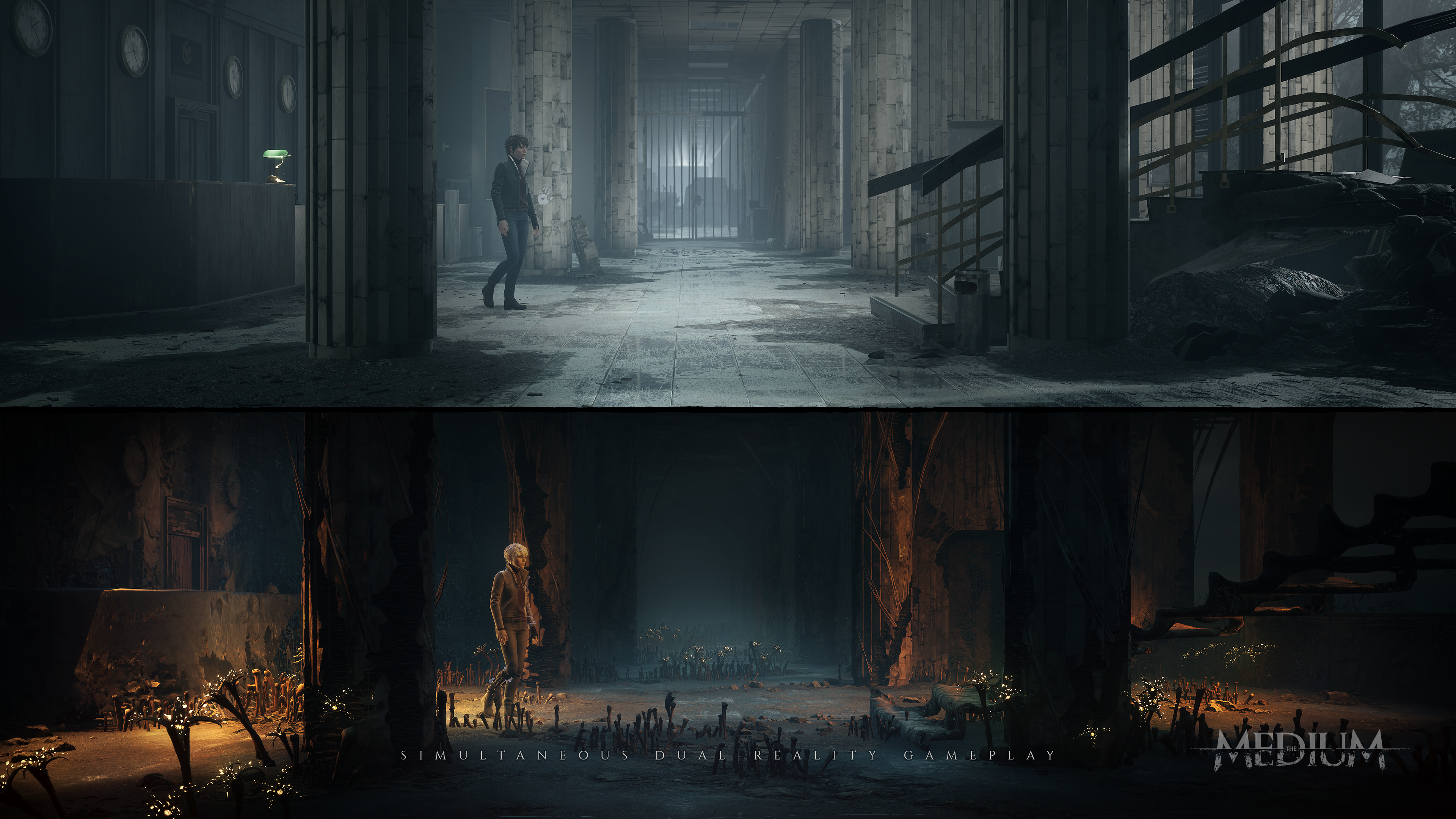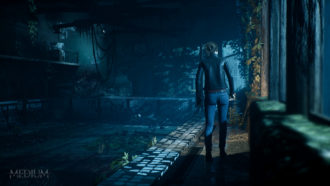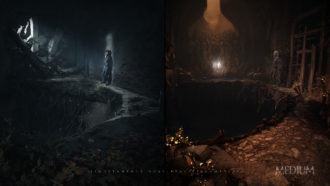Platforms:
PC, Xbox Series X|S
Released:
January 28, 2021
Publisher:
Bloober Team
Developer:
Bloober Team
Coming into The Medium, developer Bloober Team has a lot to prove. They’ve been refining their horror craft over the last few years, with titles such as Layers of Fear, Observer and Blair Witch delivering on their own brand of psychological horror that constantly reminded us in those worlds that things are never exactly as they seem. On top of the pressure to continue improving, this new title is one of the very first Xbox Series X/S console exclusives, not available on previous generations like so many other current-gen titles, further raising expectations. The Medium is certainly their biggest game yet, with a compelling and likeable lead character, truly unique concepts for the genre and a clear love of horror games from history propelling it forward. It’s absolutely the best work that Bloober Team has done and is a strong, spooky and satisfying adventure in its own right that cleverly utilises the current generation hardware to create something truly memorable.
In The Medium, you play as Marianne, a young woman with an uncanny gift to connect to the “spirit world” via her psychic abilities. She has recurring dreams about a young girl being killed, and after a tragic event in her own life receives a phone call from a stranger, summoning her to meet him at the Niwa Hotel. A bit strange, but even worse is that Niwa is home to an awful massacre that took place years ago. Using Marianne’s gift, you have to figure out why you’ve been brought here, uncover the dark secrets of the town and its former inhabitants and figure out just what the hell is going on. Perhaps not surprising, there’s a lot more nuance involved than just a simple ghost story.
Marianne herself is a very likeable protagonist. She has a tendency to over-explain things, which I feel like may be just part of the gig of being a medium, but I warmed to her quite quickly as she seems to genuinely care about the spirits she encounters and wants to help them find peace. There’s also some witty moments that create some levity in an otherwise dark and dreary setting, with subtle nods to the tropes of the genre and one particularly funny ongoing gag with a pair of bolt cutters. One of the early characters you’ll meet is a little girl named Sadness, who becomes a sort of ally as you navigate the spooky hallways and dilapidated rooms of the hotel. But the main hook of The Medium is around how your perspective changes your perception, and that’s where the game’s most inspired mechanic comes into play.
The trademark feature, Dual-Reality Gameplay, takes shape when the material world that you inhabit splits in two and gives Marianne access to the spirit world at the same time. You control Marianne within both worlds at once, a literal split-screen taking form vertically or horizontally depending on the area you’re in. Impressively, both of these worlds are rendered simultaneously on screen, which is where the power of the Xbox Series X and beefy PCs comes into play. It’s really impressive, a wonderful and innovative idea that is implemented very thoughtfully throughout. As a horror game fan from a long way back, I can’t think of a brand new mechanic or idea that has felt truly unique and exciting like this in a very long time.
“…as a horror game fan from a long way back, I can’t think of a brand new mechanic or idea that has felt truly unique and compelling like this in a very long time.”
The two worlds require you to move between them to solve puzzles, as there are elements in each that have a direct impact on both. An early puzzle has you searching for an energy source in the spirit world so that you can charge an electrical fuse box in the material world to get an elevator running. Later on, you can flip between the two realities via moving through literal mirrors, with access to specific items only available in one world or another. The dual-reality gameplay sections are used cleverly and sparingly throughout the adventure, so it’s not something that gets old quickly by any means. About a third of the game takes place in the material world, a third in the spirit world and a third with the split in effect. This allows the story to weave in and out of the worlds as necessary, so the concept is used as a story-telling device that offers different points of view just as much as it’s used to impact gameplay itself.
Additionally, cutscenes don’t just render shot for shot like the dual-reality gameplay sections do. Instead, they show different camera angles and mix perspectives for each reality, making them feel cinematic but still blending it with the two worlds concept. It ensures that the visual trickery is always impressive, with a clear contrast in aesthetic between each world. They’re both stunning in their own way; the material world is appropriately dark and stormy, the location being abandoned a long time ago and left to rot. The building is falling apart and searching through the empty lobby, swimming pool and kids play room all have appropriately creepy vibes, all with full ray-tracing on the Xbox Series X and PC allowing for the minimal lighting and reflections to really stand out in the darkness.
On the flipside, the spirit world is a strange, fleshy sort of place, where the walls seem to pulsate, bones are littered about, corpses strung up to suffer and pathways are literally sealed by a blanket of skin that must be sliced through. It’s based on a style called “dystopian surrealism” which is inspired by Polish artist Zdzisław Beksiński, very gothic and abstract. The spirit world also comes with some threats, but there isn’t any form of combat in the game so they must be dealt with using stealth and avoidance. This, in particular, makes each trip to the spirit world fill you with a sense of dread; while the material world is certainly spooky, it doesn’t have the same threatening aura that the more-horrific spirit world offers. It creates a sense of tension where I didn’t want to be in the spirit world exclusively for longer than I had to, as I felt a monster could be lurking around any corner.

If you do happen to be caught by the creature stalking you, known as The Maw, it’s an instant death and a reload of a recent checkpoint. I don’t normally love this style in horror games, especially when combined with stealth, but at least in these scenes there are plenty of opportunities to be patient and watch patterns of movement before proceeding, so that being caught doesn’t feel cheap. There are times when you have to hold your breath while crouching and moving slowly around an area to prevent being spotted, and that can feel a bit finicky at times holding down so many buttons at once, but these moments where you’re at risk always had my heart up in my throat as I slowly moved through and hoped for survival. The fact that the very talented Troy Baker voices The Maw that stalks you while saying devilishly gross lines about wearing your skin as an outfit will send chills up your spine.
Another idea that only sometimes works well is where Marianne can have an out of body experience; that is, her spirit form can temporarily leave her body to visit new areas that aren’t accessible in the material world in order to solve puzzles. I didn’t mind it as a concept, but if you stay in the spirit world in this way for too long, your spirit body eventually deteriorates and results in your death. You can return to your physical body easily enough at any time, but then you simply have to start that puzzle again, which can result in some repetitive trial-and-error where the roadblock was more about not knowing where to go as opposed to not being able to figure out the solution. That being said, stages of the late game had a much better implementation of this system that brought me around to liking it more.
Some of the other puzzles in The Medium do feel like they’re from a simpler time, utilising varying combinations of “find the right piece to insert into the right slot”. Considering the linear nature of the game, these won’t test your brainpower for the most part, as the items you’re able to pick up will often find their home somewhere relatively nearby. That’s not to say there aren’t some elaborate riddles to solve along the way as well that have fresher ideas – in fact, the game is at its best when it cleverly finds ways to mix the two realities together to find the solve – but they can’t entirely shake the old-school horror tropes, with doors locked shut with a chain one of the most persistent nuisances you’ll encounter.
Initially I was taken aback by The Medium’s semi-fixed cameras; the game is inspired by classic horror games, and with so many modern horror titles opting for a strictly first-person or third-person camera perspective, it was a little bit jarring at first recalibrating my brain to accommodate the controls and how Marianne moves from space to space. It also means that her movements can feel a little bit clunky. It’s only particularly noticeable in smaller areas, but Bloober Team noted that moving the camera freely in the dual-reality sections of the game caused nausea in many players, and having played it myself I can completely see why that would be the case. The semi-fixed cameras definitely play into the aesthetic really well, just know that it may take a little getting used to.
It’s worth noting that this is not a game focused on jump scares, opting for the more Silent Hill-esque approach of creating a disturbing and oppressive atmosphere that keeps you on edge rather than shocking you out of your seat. Marianne as a medium can see, hear and feel more than others, so the story involves her exploring areas, encountering spirits who may or may not need her help, unpacking their tragedy and, ultimately, figuring out her own connection to it all. You can gain insights from objects left behind in order to find out more about the spirits untimely deaths, and points of recollection can be discovered, recreating scenes like echoes of the horrid past that haunt the souls of Niwa. Without spoiling anything, the conclusion of the game felt somewhat quick in what I feel will be a divisive ending for some, but the story does take you to places you won’t expect and to a finale that you likely won’t see coming, which is worth applauding. I have continued to think about The Medium for days after I completed it, a testament to a story that has real thought and passion behind its creation.
It would be remiss of me not to mention the beautifully composed soundtrack of Arkadiusz Reikowski, who worked on the material world soundtrack, and Akira Yamaoka, who worked on the spirit world soundtrack. To this day, the haunting tunes in early Silent Hill titles from Akira Yamaoka are some of my absolute favourites of all time, and my ears recognised the atmospheric mastery of the legendary video game composer straight away. The unsettling nature of his dark ambient style pairs so wonderfully with the spirit world of The Medium, adding another layer to the darkness that further highlights the sense of terror and trepidation Marianne is experiencing. The fact that these two talented composers have collaborated in this way (with elements of both soundtracks blending in the dual-reality sections) is brilliant.
9
Amazing
Positive:
- Dual-reality gameplay is genuinely innovative and impressive
- Creative puzzle-solving between both worlds
- Compelling story with a likeable main character
- Gorgeous visuals throughout and a wonderfully atmospheric soundtrack
Negative:
- Some puzzles come across as a little simple or are more a matter of trial-and-error
The Medium feels like a culmination of everything Bloober Team has learned from their previous titles, pushing the envelope creatively while still heavily referencing classic horror games as their inspiration. The developers refer to it as a “love letter to Silent Hill 2”, and those references really ooze out of every design choice that they’ve made. The adventure does an excellent job of immersing you in its dark and twisted world, full of tortured souls and dark secrets begging to be uncovered. The dual-reality gameplay adds a fantastic riff to proceedings, a mechanic that has been cleverly injected into the gameplay and story in a really compelling way. While it could stand to leave some of its old-school sensibilities behind, its heartfelt story and creepy setting demand your attention right up until the credits roll. The Medium is cemented as one of the most gripping and innovative horror games in a long time and is an absolute must-play for fans of the genre.











